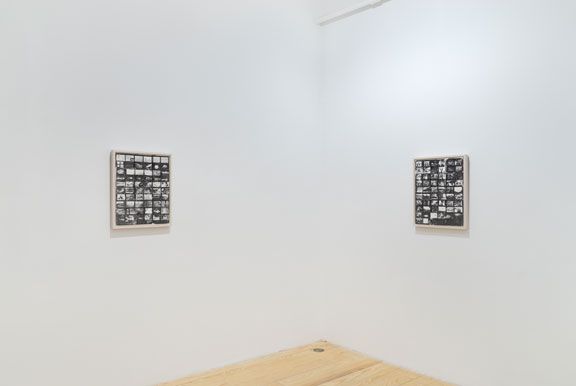Mistaken For A Centaur 21 May 2009 - 24 July 2009
In VIOLET HOPKINS’ second solo exhibition at Foxy Production, Afraid He Might Be Mistaken For A Centaur, the artist appropriates images from the 1977 Voyager space mission’s Golden Record, its catalogue of photographs, diagrams and sounds designed to communicate life on Earth to any aliens who may be encountered en-route. Hopkins reproduces a number of these images in ink on paper, and then anchors the exhibition with two large paintings: one of the record’s instructional cover, and the other of an eye reflecting a solar eclipse.
The exhibition conflates past, present and future in a conceptual but affective exploration of perception. Hopkins highlights the cultural assumptions embedded in the Golden Record project, taking a laconic yet immersive approach to the values it embraces. She underscores the mission’s glorious ambitions with a sense of loss: using photography as a central theme, she explores the limitation of possibilities inherent in fixing an image to a concept.
Purposefully mixing idealism with an undercurrent of anxiety, Hopkins’ Golden Record series resembles a set of frames from a long-forgotten documentary. Some of the images – a naked pregnant Caucasian woman holding hands with her lover, a male artist painting in his studio with his female muse – highlight the catalogue’s unacknowledged presumptions about who should be represented and how. Other images seemly oddly random – a small frog and a huge alligator scaled by the presence of a human, people walking the great Wall of China, a close up of sea-shell – forcing one to attempt to make sense of their inclusion.
These watercolor paintings are drawn from online images of slides of the Golden Record photographs, and bear witness to the complex layers of appropriation and change that the images have undergone over time. The originals are almost impossible to access in their pristine form, and Hopkins’ works, with their faded quality and at times magenta tinting, evoke an emotive sense of time passed.
Hopkins’ large painting of the catalogue’s cover appears at first to be the depiction of a circular monument covered in ancient hieroglyphics. The purpose of the inscriptions is illusive: only the original producers would be able to read its symbols; an alien would certainly be stumped. Despite its illegibility, it possesses a strange beauty: its golden lines form odd shapes that cajole one’s imagination to find meaning.
Hopkins’ large painting of an eye reflecting a solar eclipse is distinctly cinematic in style, complexly exploring the relationship between image-taker, image and viewer. On close inspection, the work’s intense, over-arching realism dissolves into painterly abstraction, encapsulating the central themes of the exhibition as a whole: the work’s haunting eclipse figures contemporary anxieties about the future, while the surrounding eye highlights the critical importance of coming to terms with subjectivity.
VIOLET HOPKINS’ drawings and paintings combine layers of appropriation with both a visceral realism and an expressive sense of fantasy. Often inspired by found images of the natural world, Hopkins uses ink, paint, and pencil to conjure vivid scenes that seamlessly incorporate figurative and abstract elements. Her subjects – wild animals, geological formations, flora – transform into abstract patterning, membrane-like forms, and hallucinatory movements. Her renderings of line and color highlight the drawing process, while allowing shifts in consciousness between the real and the imagined. Her works fuse an external world of nature with a psychic world of symbolism and allegory.
Credits
Installation photography by Mark Woods.


